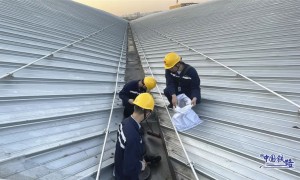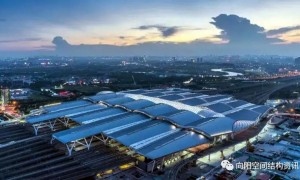原文发表信息:
Journal of Construction Innovation: Information, Process, Management,
《建设创新:信息、过程、管理》
Volume 12 issue 2 https://doi.org/10.1108/14714171211215921
© Emerald Group Publishing Limited 2012
作者:
Thomas Linner
Technische Universität München
Thomas Bock
Technische Universität München
Evolution of large-scale Industrialisation and Service -Innovation in Japanese Prefabrication Industry
日本预制建筑大规模工业化的演变和服务创新
Abstract
摘要
Purpose – The Japanese prefabrication industry not only has automated its processes to a high extent, but it also innovates due to the fact that it delivers buildings of outstanding quality accompanied by a multitude of services. In order to explore and specify the concepts and parameters that have driven this industry, Japan’s prefabrication industry, its cultural, economic and technological surrounding, as well as the applied processes, technologies and economic strategies, have to be illustrated and analyzed. The proposed research aim was to identify, describe and analyse these concepts and their related parameters, as well as to recognize the most influential drivers for the future, that provide an indication into which direction the industry could evolve.
目的:日本的预制工业不仅在很大程度上实现了过程自动化,而且还在不断创新,因为它提供的建筑质量上乘,同时提供多种服务。为了探索和明确驱动这个产业的概念和参数,必须说明和分析日本的预制工业,其文化、经济和技术环境,以及应用的过程、技术和经济策略。拟议的研究目的是识别、描述和分析这些概念及其相关参数,以及识别未来最有影响力的驱动因素,为该行业的发展方向提供指示。
Research Methodology – Being aware that literature does not provide relevant information and data, which would allow the authors to explore concepts and parameters explaining the success of the Japanese prefabrication industry, the authors performed field surveys, visited factories, R&D centres and sales points of all major Japanese prefabrication companies. In some cases authors also interviewed general managers, researchers and developers, and academicians at Japanese universities. Based on an extensive literature review in the area of product development, production technology, modularisation, mass customisation, and innovation, the authors qualitatively and quantitatively analysed all major prefabrication companies according to a fixed scheme.
研究方法:意识到文学并没有提供相关的信息和数据,这将允许作者探索概念和参数解释日本预制行业的成功,作者进行了实地调查,参观工厂,R& D中心和销售的所有主要日本预制的公司。在某些情况下,作者还采访了日本大学的总经理、研究人员和开发人员以及学者。基于在产品开发、生产技术、模块化、大规模定制和创新领域广泛的文献综述,作者定性和定量地根据一个固定的方案分析了所有主要的预制制造公司。
Findings – The concepts and parameters identified and analyzed in this paper, demonstrate that the Japanese prefabrication industry, which is leading in large-scale industrialization, nowadays focuses towards services that are related to the building’s utilization phase, rather than delivering products. By involving customers it enhances the companies’ customer relations, creating thus competitive advantages.
研究结果:本文中确定和分析的概念和参数表明,在大规模工业化中处于领先地位的日本预制建筑行业,如今关注的是与建筑使用阶段相关的服务,而不是交付产品。通过吸引客户,它可以加强公司的客户关系,从而创造竞争优势。
Originality/ value – Overall the paper shows that Japanese prefabrication industry rather acts like a “production industry” than a “construction industry”. Similar to many other high-tech industries, Japan’s prefabrication industry incorporates latest product and process technologies and combines automation, products and services into complex value-capturing systems.
创意/价值:总体而言,这篇论文表明,日本的预制工业更像是“生产工业”,而不是“建筑工业”。与许多其他高科技产业一样,日本的预制制造产业整合了最新的产品和工艺技术,并将自动化、产品和服务结合到复杂的价值获取系统中。
Keywords: Building Production, Automation in Construction, Product and Service Innovation, Mass Customization, Japanese Prefabrication Industry
关键词:建筑生产、建筑自动化、产品和服务创新、大规模定制、日本预制制造产业
Category: Research/ Case Study
类别:研究/个案研究
Introduction
介绍
Prefabrication holds a considerable share in the housing market in many European countries, such as Germany (15%), Austria (up to 33%), France (5%), Spain (5%) and the Scandinavian Countries. In Germany, currently about 20,000 prefabricated houses are delivered per year by companies as Bien-Zenker AG (580 houses/ year), Huf Haus GmbH (450 houses/ year), Weber Haus GmbH (600 houses/ year) and Kampa House GmbH (1,086 houses/ year). The advantage of buying prefabricated buildings is the low price compared to conventionally built buildings and the relatively rapid delivery (about six days period of delivery). However, the European prefabrication industry cannot really be considered industrialized. According to classical theory (e.g. Henry Ford’s Mass Production) as well as modern concepts (e.g. flexible manufacturing, mass customization), industrialization implies that large scales of products were produced using latest production technology, automation, robotics, Information and Communication Technology (ICT), in order to deliver high quality products with reasonable costs. In Europe, no prefabrication company has yet reached the critical mass of an annual production, which would allow for investment in efficient processes and automation. It rather seems that conventional construction processes have been shifted to the factory and combined with elements of shop floor production. Furthermore, prefabrication in Europe has predominantly found its niche in the low cost market, which doesn’t allow for product or service innovation. Unlike Japanese prefabricated buildings, the choices available to European customers to individualize those houses are rather low.
预制建筑在许多欧洲国家的房屋市场占有相当大的份额,如德国(15%),奥地利(33%),法国(5%),西班牙(5%)和斯堪的纳维亚国家。在德国,Bien-Zenker AG公司(580套房屋/年)、Huf Haus公司(450套房屋/年)、Weber Haus公司(600套房屋/年)和Kampa House公司(1,086套房屋/年)每年大约交付20,000套预制房屋。购买预制件建筑的优点是,与传统建筑相比,价格低廉,交货相对迅速(交货期约为6天)。然而,欧洲的预制工业不能真正被认为是工业化的。根据经典理论(例如亨利•福特(Henry Ford)年代大规模生产)以及现代概念(如柔性制造、大规模定制),工业化意味着大规模生产的产品都是使用最新的生产技术,自动化,机器人技术,信息和通信技术(ICT),以提供高质量的产品和合理的成本。在欧洲,还没有一家预制建筑公司达到年生产的临界量,这将允许对高效流程和自动化进行投资。传统的施工流程似乎已经转移到工厂,并与车间生产的要素结合在一起。此外,预制在欧洲已经在低成本市场找到了它的利基,这是不允许产品或服务创新。与日本的预制建筑不同,欧洲客户可以选择个性化的房屋是相当低的。
In Japan, the prefabrication industry mainly deals with middle to high-end market (Matsumura, 2007; Linner, 2007), for which it delivers highly customized and reliable products that are equipped with the latest technology available and accompanied by a variety of services. Above all, prefab houses are well known for being earthquake resistant. Various maintenance models guarantee the building’s functionality for at least thirty years, and some companies offer even sixty years of service. Prefabrication companies altogether build about 150,000 housing units per annum. The following can be considered as a comparison: In 2008, the same amount of building permissions in private housing in Germany were issued both in conventional and prefabricated construction. Already in the nineteen-seventies, Sekisui Heim’s legendary M1 reached an annual production volume of more than 3,000 buildings. A high annual production rate on a steady level allowed the investment in component systems, expensive manufacturing technology (e.g. production lines, automation, and robotics, advanced logistic systems) and extended customer services, which are labelling the uniqueness and strength of the Japanese prefabrication industry today. Moreover, the productivity of this industry has become so high, depending on the capacity utilization, that three to four customized buildings per employee can be realized annually (Sekisui Heim, 2008; Sekisui House, 2008). Japan’s housing industry is amongst the strongest industries worldwide. However, it has undergone a steady change and decline since the 1990’s. The maximum production peak was reached in 1994 with 573,173 newly constructed housing units. In 2000, about 450,000 units were constructed and in 2009 the construction went down to just 318,000 units. During peak times, the percentage of prefabricated houses, which were entirely prefabricated, was about 18 to 19 %. Today’s quota has decreased to just 13 to 15%, depending on the region (Sekisui Heim, 2010; Toyota Home, 2010). However, also in conventional construction, a high amount of prefabricated elements were used, which increases the actual percentage of prefabrication in the whole building industry, although it is difficult to give numbers. The prefabrication of entire buildings can be broken down into about 80% steel-based building kits, 15% wood-based building kits and 5% concrete-based building kits.
在日本,预制建筑行业主要面向中高端市场(Matsumura, 2007;Linner, 2007),为其提供高度定制和可靠的产品,配备了最新的技术,并伴随各种服务。最重要的是,预制房屋以防震而闻名。各种维修模式保证建筑物至少30年的使用寿命,有些公司甚至提供60年的使用寿命。预制建筑公司每年总共建造约15万套住房。以下可以作为比较:在2008年,德国颁发了相同数量的私人住宅建筑许可,无论是传统建筑还是预制建筑。早在十九世纪七十年代,Sekisui Heim的传奇M1就达到了年产3000多栋建筑的规模。在稳定水平上的高年生产率使得在组件系统、昂贵的制造技术(如生产线、自动化和机器人、先进的物流系统)和扩展的客户服务方面的投资成为可能,这些都标志着今天日本预制制造行业的独特性和实力。此外,这个行业的生产力已经变得如此之高,取决于产能利用率,以至于每个员工每年可以实现3到4栋定制建筑(Sekisui Heim, 2008;Sekisui房子,2008)。日本的房地产业是世界上最强大的产业之一。然而,自20世纪90年代以来,它经历了一个稳定的变化和衰退。1994年达到了生产的最高高峰,新建了573 173套住房。2000年,大约建造了45万套住房,而到了2009年,建筑数量下降到只有31.8万套。在高峰期,全是预制房屋的比例约为18%至19%。根据地区的不同,如今的配额已减少到只有13%至15%(塞基斯·海姆,2010年;丰田的家,2010)。然而,在传统建筑中,也使用了大量的预制构件,这增加了整个建筑行业中预制构件的实际百分比,尽管很难给出具体数字。整个建筑的预制可以分解为大约80%的钢基建筑组件,15%的木材基建筑组件和5%的混凝土基建筑组件。
Table 1: Maximum production peaks in housing of main players of the prefabrication industry.
表1:在预制制造行业的主要参与者的住房的最大生产高峰。
Source: Yearly financial reports of Sekisui House, Daiwa House, Sekisui Heim and Toyota Home∗
资料来源:积水房屋、大和房屋、积水海姆、丰田之家的年度财务报告
Sekisui House, which remains the main player in Japan’s prefabrication industry, reached its peak in 1994 with a production of 78,275 housing units. At this time, Sekisui’s quota of the total building construction market was 5,3%. Both Sekisui House and Daiwa House, the second largest player in Japan’s prefabrication industry, tried to encounter the decline in the market by going into a developer position. Houses and apartments were developed, planned and constructed in order to rent them out later. These houses and apartments are also based on mass customisable housing kits and ensure that the capacities of expensive automated production facilities are utilised to a maximum.
Sekisui House仍然是日本预制建筑行业的主要参与者,它在1994年达到顶峰,生产了78275套住宅单元。在这个时候,Sekisui的总建筑市场份额是5,3%。Sekisui House和大和房建(Daiwa House)都试图通过成为开发商来应对市场下滑。大和房建是日本预制建筑行业的第二大开发商。房屋和公寓的开发、规划和建造是为了以后能出租。这些房屋和公寓也是基于大规模定制的住房套件,并确保昂贵的自动化生产设施的能力得到最大限度的利用。
Table 2: Housing production of main players in 2009.
表2:2009年主要住户的房屋生产情况。
Source: Yearly financial reports of Sekisui House, Daiwa House, Sekisui Heim and Toyota Home ∗
资料来源:积水房屋、大和House、积水海姆、丰田之家年度财务报告
To address the decrease in demand and to build up new ways of value creation, all main players are focusing more and more on the building’s utilization phase, building performance and advanced Building Information Modelling (BIM), in order to manage the building’s life-cycle and provision of more and more services accompanying the hard physical product.
解决需求的减少和建立新的价值创造方式,所有主要参与者都越来越关注建筑的利用阶段,建筑性能和先进的建筑信息模型(BIM),为了管理建筑的生命周期和提供越来越多的服务伴随实体产品。
Research Question
研究问题
Comparing the European and the Japanese prefabrication market using the aforementioned facts and figures, it can be concluded that prefabrication in Japan is much more industrialized. This means that companies have higher production volumes, along with standardized processes, just-in-time, automation and flow line-like production, (together with human work activity), in all factories of the four biggest prefabrication companies. Despite this high degree of industrialization, prefabricated buildings are considered as the most customized, reliable, technology-equipped and properly designed buildings in Japan. Above all, Japanese prefabrication companies have managed to bundle a variety of customer services to their buildings. Thus, Japanese prefabrication industry is not only to a high extend industrialized but at the same time innovative, as it delivers buildings of outstanding quality (customized, earth quake resistant, properly designed, reliable, equipped with the latest technology). Now this industry even starts to create a completely new business services. In order to explore and specify the concepts and parameters that have driven this industry its’ cultural, economic and technological surrounding as well as applied processes, technologies and economic strategies have to be described and analyzed. As in many success stories of complex socio-technical systems (Fujimoto, 1999), we assume that the success of Japan’s prefabrication industry today, was also based on a complex relation of concepts and parameters, that evolved out of historic and cultural developments. The research aim is to identify, describe and justify these concepts and related parameters, and to recognize the most likely and influential drivers for the future, that provide an indication in which direction the industry could evolve.
利用上述事实和数据,比较欧洲和日本的预制市场,可以得出日本的预制更加工业化的结论。这意味着,在四大预制件公司的所有工厂中,随着标准化流程、准时制、自动化和流水线式生产(以及人工工作活动),公司的产量更高。尽管工业化程度很高,但预制建筑被认为是日本最定制化、最可靠、技术装备最完善、设计最合理的建筑。最重要的是,日本的预制建筑公司已经成功地将各种客户服务捆绑到他们的建筑中。因此,日本的预制工业不仅是高度工业化的,同时也是创新的,因为它提供的建筑质量优秀(定制,防震,适当的设计,可靠,配备最新的技术)。现在这个行业甚至开始创建一个全新的业务服务。为了探索和明确驱动该行业的文化、经济和技术环境以及应用过程的概念和参数,必须描述和分析技术和经济战略。正如许多复杂的社会-技术系统的成功故事(藤本,1999)一样,我们认为日本今天的预制工业的成功也是基于概念和参数的复杂关系,这是由历史和文化发展演变而来的。研究的目的是识别、描述和证明这些概念和相关参数,并识别未来最有可能和最有影响力的驱动因素,为该行业的发展方向提供指示。
Research Methodology
研究方法论
Large scale industrialization and automation is a rare phenomenon that was not only discussed theoretically, but also applied in real life. The Moma Catalogue (Bergdoll and Christensen, 2008), accompanying the 2008 exhibition “Home Delivery”, is one of the most recent collections of concepts, projects and real-life examples of prefabricated buildings. It clearly revealed that most ideas about prefabrication remain abstract concepts (Archigram, Metastadt), others are only built once or a few times, and only a few have reached a reasonable production number (e.g. some systems of Jean Prove). Similarly, none of the building systems mentioned, analysed and discussed in the book “New Perspective in Industrialization in Construction – A State-of-the-Art Report”, published in 2010 and co-authored by experts from CIB’s TG 57 (Girmscheid and Scheublin, 2010), has reached an extent of production that is comparable to the mentioned Japanese systems. Comparable amounts, or a comparable degree, of automation has not been achieved even in the prefabrication of concrete elements for the civil engineering and infrastructure sector (Bock and Linner, 2010; Girmscheid, 2010). Furthermore, in the area of open building systems, most systems discussed are conceptual or experimental (Habraken, 2000; Kendall and Teicher, 2000). As mentioned in literature, you cannot extract guidelines that determine success, especially when dealing with concepts or projects, which are applied in larger scales. Due to cultural barriers and limited access of foreigners to the Japanese society, economy and technology, only a few international publications about the Japanese prefabrication market have been proposed. In (Wimmer, 2009), the author visited Sekisui House and mainly discusses the resource efficiency of the Japanese prefabrication industry. In (Johnson, 2008), economic concepts of the Japanese prefabrication market are discussed and comparisons to the market of the United Kingdom are made. Nevertheless, the author does not mention in detail the production technology and the service aspects. Similarly, (Andersson, et al., 2010) deals with the application of building information modelling in the Japanese prefabrication industry, without mentioning the context in which this happens. In general, researchers of Japanese prefabrication companies do not easily publish about their own technologies. One of the rare publications about the production system (Furuse and Katano, 2006), was issued in the International Symposium on Automation and Robotics in Construction held in Tokyo. Further books, brochures and websites, directly from the Japanese prefabrication companies, are predominantly written in Japanese language and do not reveal details about strategies and technologies. Being aware of the situation that literature does not provide relevant information and data, which would allow the authors to explore concepts and parameters in order to explain the success of Japanese prefabrication, the authors started a field survey. Visits to factories, R&D centres and sales points of all four mentioned prefabrication companies, were conducted. The authors also interviewed general managers, researchers and developers (Sekisui House, 2008 and 2009; Daiwa House, 2008; Sekisui Heim, 2008 and 2010; Toyota Home, 2008, 2009 and 2010). Furthermore, they interviewed researchers at the University of Tokyo and the Kyushu University, which were familiar with the subject. Based on extensive literature review in the area of product development, production technology, modularization, mass customization and innovation (Baldwin and Clark, 2000;Ohno, 1988; Maraghy and Wiendahl, 2009; Piller, 2006; Chesbrough, 2011; Forza and Salvador, 2007), the authors qualitatively and quantitatively analyzed all four mentioned companies during their field survey, concerning the designed scheme to reflect the value chain:
大规模工业化和自动化是一个罕见的现象,不仅在理论上被讨论,而且在现实生活中得到了应用。现代艺术博物馆(Moma)的目录(Bergdoll和Christensen, 2008年),伴随着2008年的“送货上门”展览,是预制建筑的最新概念、项目和现实范例的集合之一。它清楚地揭示了大多数关于预制的想法仍然是抽象的概念(Archigram, Metastadt),其他的只是建造了一次或几次,并且只有少数达到了合理的生产数量(例如一些系统的Jean Prove)。同样,没有提到的建筑系统,分析和讨论了在书中新的视角在工业化建设一个先进的报告,出版于2010年,由专家从CIB年代TG 57 (Girmscheid Scheublin, 2010),已达到一个程度比得上提到日本的生产系统。即使在土木工程和基础设施部门的混凝土构件预制中,也没有实现可比较的数量或程度的自动化(博克和林纳,2010年;Girmscheid, 2010)。此外,在开放建筑系统领域,讨论的大多数系统都是概念性或实验性的(Habraken, 2000;Kendall and Teicher, 2000)。正如在文献中提到的,您不能提取决定成功的指导方针,特别是在处理概念或项目时,它们被应用于更大的规模。由于文化障碍和外国人接触日本社会、经济和技术的渠道有限,有关日本预制建筑市场的国际出版物寥寥无几。在(Wimmer, 2009)中,作者参观了Sekisui House,主要讨论了日本预制行业的资源效率问题。在(Johnson, 2008)中,讨论了日本预制市场的经济概念,并与英国市场进行了比较。但是,在生产技术和服务方面,作者并没有详细提及。类似地,(Andersson等人,2010)处理了建筑信息建模在日本预制行业中的应用,但没有提及发生这种情况的上下文。一般来说,日本预制建筑公司的研究人员不会轻易发表他们自己的技术。关于生产系统的罕见出版物之一(Furuse和Katano, 2006)在东京举行的建筑自动化和机器人技术国际研讨会上发表。其他直接来自日本预制建筑公司的书籍、小册子和网站主要是用日语写的,没有透露有关战略和技术的细节。了解到文献没有提供相关信息和数据的情况,这将允许作者探索概念和参数,以解释日本预制的成功,作者开始了实地调查。他们走访了上述四家预制建筑公司的工厂、研发中心和销售点。作者还采访了总经理、研究人员和开发人员(Sekisui House, 2008年和2009年;大和房建,2008;Sekisui Heim, 2008年和2010年;丰田家居,2008,2009和2010)。此外,他们还采访了熟悉这一课题的东京大学和九州大学的研究人员。基于对产品开发、生产技术、模块化、大规模定制和创新领域的广泛文献综述(Baldwin和Clark, 2000;Ohno, 1988;Maraghy和Wiendahl, 2009年;皮,2006;两,2011;Forza和Salvador, 2007),作者在他们的实地调查中定性和定量地分析了所有提到的四家公司,关于设计方案来反映价值链
1. Evolution of the company and the companies systems
2. Design Aspects: product structure, modularization, design for production
3. Degree of customer integration
4. Supply chain management
5. Off-Site Process: Automation and production technology, factory layouts
6. On-Site Process: completion process on site
7. Life-cycle management and customer relationship
8. Service Innovation
1. 公司和公司制度的演变
2.设计方面:产品结构、模块化、生产设计
3.客户整合程度
4. 供应链管理
5. 场外流程:自动化和生产技术,工厂布局
6. 现场流程:现场完成流程
7. 生命周期管理和客户关系
8. 服务创新
According to their analysis, it was realised that Sekisui House and Daiwa House have a high production outcome, but compared to Sekisui Heim and Toyota Home, they have a lower degree of automation and work tasks done in the factory. Toyota Home performs about 85% of all works in the factory, (highest degree of prefabrication), but hardly ever produced more than 5,000 houses per annum. The Sekisui Heim company was the most interesting to the authors. Sekisui Heim has applied a flow production on the production line which was very close to automotive industry, regarding organisation and appearance. Sekisui Heim has a medium sized production outcome and a prefabrication degree of about 80%. In this paper, the authors therefore focus on Sekisui Heim and identify, describe and analyse parameters that are relevant for efficient large scale industrialization. The other companies will be analysed in further papers. Comparative analysis of all four companies mentioned above will be also realized in further papers.
根据他们的分析,他们意识到Sekisui House和大和House的生产效率很高,但与Sekisui Heim和丰田Home相比,他们的自动化程度较低,工作任务也在工厂完成。丰田家居完成了工厂85%的工作,(最高程度的预制),但几乎从来没有生产超过5000个房子每年。对作者来说,Sekisui Heim公司是最有趣的。在组织和外观方面,积水海姆在生产线上采用了非常接近汽车工业的流程生产。Sekisui Heim拥有中等规模的生产成果和约80%的预制度。因此,在这篇论文中,作者将重点放在了Sekisui Heim上,并识别、描述和分析了与大规模高效工业化相关的参数。其他公司将在进一步的论文中进行分析。以上四家公司的对比分析也将在以后的论文中实现。
The remainder of the paper is structured as follows: First, an analysis of how the historic and cultural development led to the evolution of large-scale industrialization is presented, by cross-linking to Sekisui House and Toyota Home, as all major companies have influenced continuously each other. Secondly, the strategies, processes and technologies deployed at Sekisui Heim today are depicted. Thirdly, it is shown that customer services play an important role in Sekisui Heim’s success and that the proposed analysis has revealed the fact that more service innovation is under development in the R&D centres of the prefabrication companies.
本文的剩余部分结构如下:首先,通过交叉链接Sekisui House和Toyota Home,分析历史文化发展如何导致大规模工业化的演变,因为所有的大公司都是相互影响的。其次,描述了目前Sekisui Heim所采用的策略、过程和技术。第三,客户服务在Sekisui Heim的成功中发挥了重要作用,所提出的分析表明,更多的服务创新正在预制建筑公司的研发中心发展。
Finally, the importance of this development for a changing housing industry is discussed. A summarization of the findings concludes the proposed paper.
最后,讨论了这一发展对一个不断变化的住宅行业的重要性。对调查结果的总结总结总结了提出的论文。
Historic and Cultural Development: the Evolution of Prefabrication in Japan
历史与文化的发展:日本预制建筑的演变








